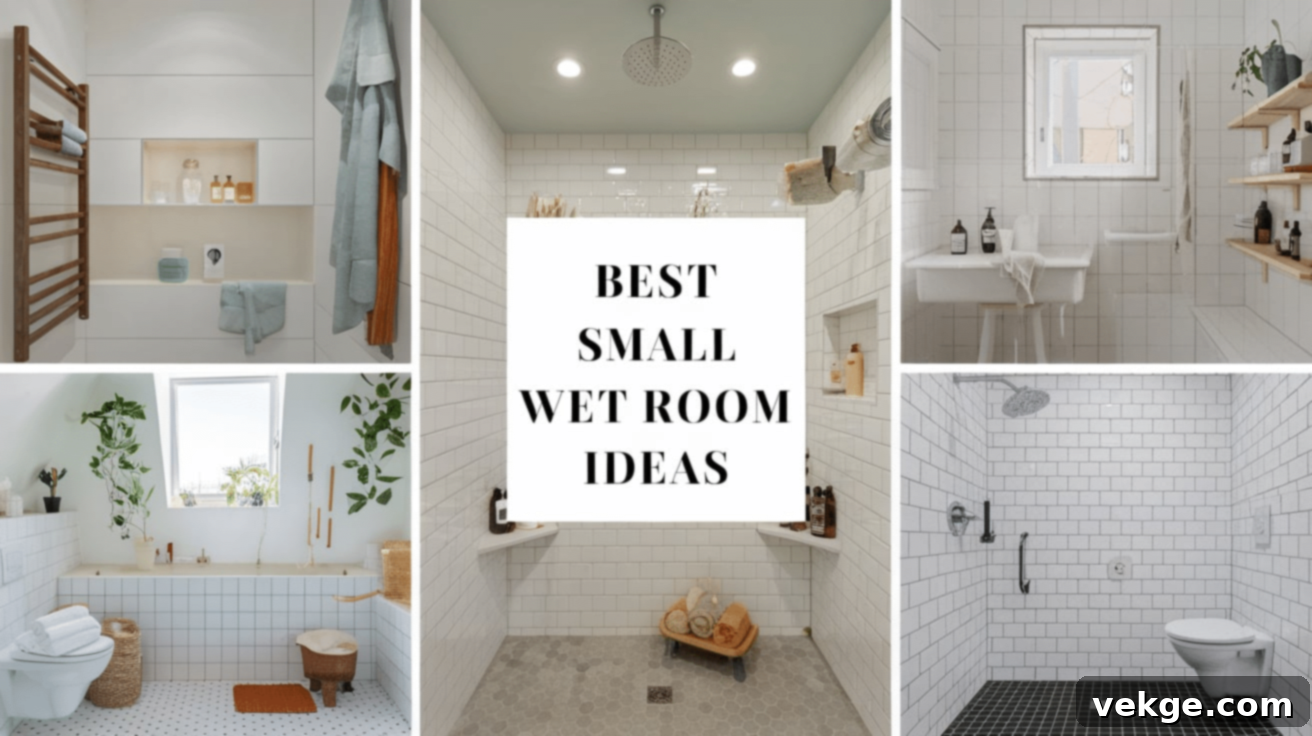Transform Your Small Bathroom: 20 Stylish Wet Room Ideas & Expert Tips
A small wet room offers an ingenious way to maximize every inch of your bathroom space. Far more than just a shower, it’s a fully waterproofed area where the shower, sink, and toilet seamlessly integrate into one open layout, creating a clean, modern, and incredibly spacious feel. If you’ve ever thought your bathroom was simply too tiny for such a luxurious upgrade, think again!
With the right layout, clever storage solutions, and smart design tricks, even the most compact space can be transformed into a functional and stylish wet room oasis. This comprehensive guide will walk you through creative and practical ideas to help you craft your ideal small wet room, from selecting space-saving fixtures to choosing easy-to-clean surfaces. Whether you’re planning a full remodel or just seeking inspiration, these expert tips will set you on the path to a beautifully efficient bathroom.
Why a Wet Room Could Be Perfect for Your Small Bathroom
A wet room redefines the traditional bathroom experience. Unlike conventional setups where the shower is confined by a tray or cubicle, a wet room involves waterproofing the entire space, allowing water to drain directly into the floor. This innovative design eliminates physical barriers, creating an uninterrupted flow that not only looks incredibly modern but also makes the room feel significantly larger and more cohesive.
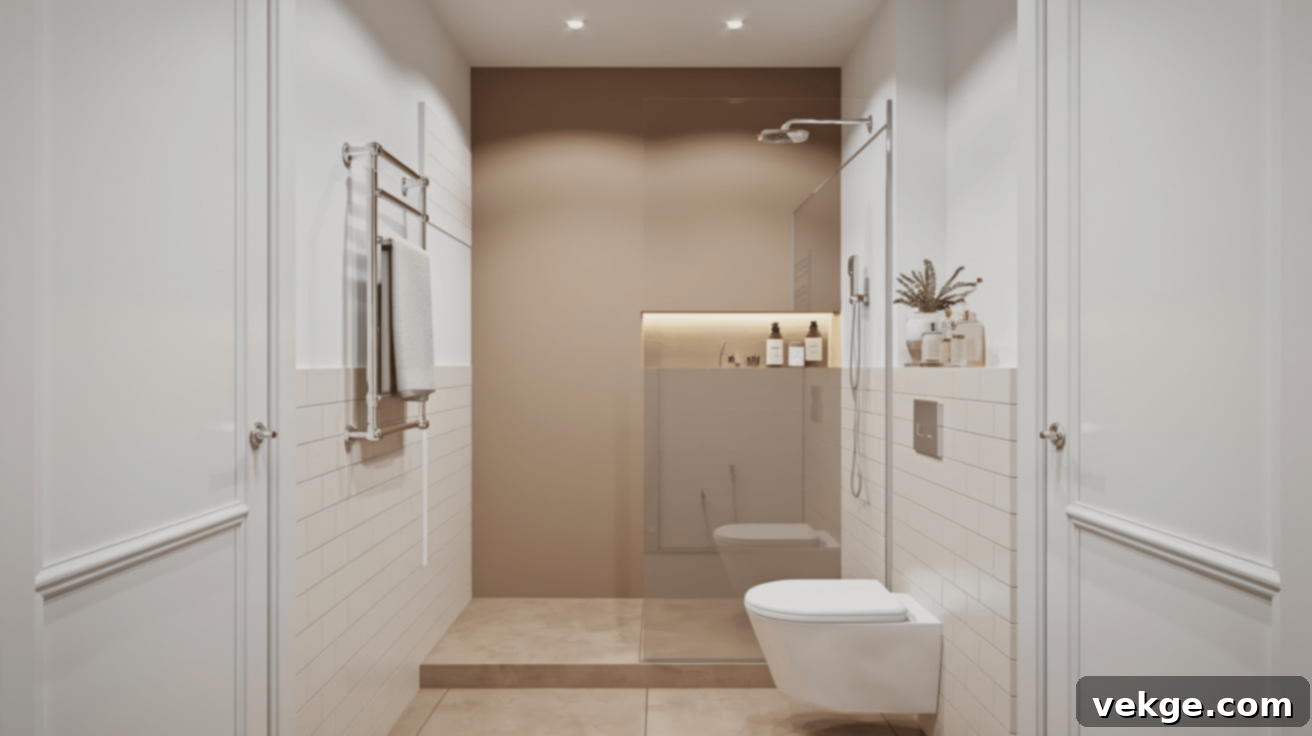
Benefits of a Wet Room
1. Saves Space: One of the primary advantages of a wet room, especially in smaller bathrooms, is its unparalleled ability to save space. By removing bulky shower enclosures, the entire room feels more open and less cluttered. This integrated design optimizes floor space, making even the most compact bathrooms feel more expansive and functional.
2. Easy to Clean: The minimalist design of a wet room, with its seamless surfaces and fewer nooks and crannies, drastically simplifies cleaning. Without shower trays, glass tracks, or tight corners where dirt and grime typically accumulate, maintaining hygiene becomes a breeze. A quick wipe-down is often all that’s needed to keep your wet room sparkling.
3. Accessibility: Wet rooms are inherently barrier-free, featuring no steps, raised trays, or enclosures. This makes them an ideal solution for enhanced accessibility, catering perfectly to children, seniors, or individuals with mobility challenges. The flat, open floor plan ensures safe and easy access for everyone, promoting independence and comfort.
4. Modern and Stylish: Beyond practicality, a wet room elevates your bathroom’s aesthetic, offering a sleek, sophisticated, and high-end look. Its contemporary design transforms a standard bathroom into a luxurious, spa-like sanctuary. The clean lines and uncluttered appearance contribute to a truly chic and inviting atmosphere.
5. Increases Home Value: A well-executed wet room is a significant asset that can substantially increase your home’s appeal and market value. Many prospective buyers are drawn to the modern elegance, spaciousness, and enhanced functionality that a stylish, open-plan wet room provides, viewing it as a desirable upgrade.
Planning and Designing Your Small Wet Room for Optimal Functionality
Before diving into the construction of your wet room, meticulous planning is paramount. A thoughtful layout combined with the right material selection will ensure your space is both stylish and supremely practical. These are the crucial considerations to factor into your design process:
1. Measure Your Space Accurately: Begin by taking precise measurements of your bathroom to fully understand the available dimensions. Even very small areas can be successfully converted into wet rooms, but it’s essential to confirm there’s adequate room for all necessary fixtures – the shower, toilet, and sink – to be positioned comfortably and functionally.
2. Choose the Right Layout: Carefully consider the placement of each fixture. Positioning the shower in a corner or against a single wall can effectively contain splashes while keeping the central floor space open. Whenever possible, orient the sink and toilet away from the direct spray zone of the shower to maintain comfort and dryness.
3. Waterproofing Is Key: Given that a wet room is designed to be entirely open to water, comprehensive waterproofing is not just important – it’s absolutely critical. A robust, continuous waterproofing layer across the floor and walls is essential to prevent leaks, protect your home’s structure, and ensure your bathroom remains in pristine condition for years to come.
4. Drainage Matters Most: Effective drainage is fundamental to a wet room’s success. The floor must be expertly sloped towards a high-performance drain to prevent water pooling and ensure rapid runoff. Linear drains are a particularly popular and efficient choice, blending seamlessly into the floor while offering superior water removal capabilities.
5. Ventilation: Adequate ventilation is an absolute must to combat dampness, condensation, and the potential for mold growth in a wet environment. If your bathroom lacks a window, investing in a powerful, properly sized extractor fan is crucial to maintain dry air and a healthy atmosphere within the wet room.
6. Pick the Right Materials: Selecting water-resistant, durable, and easy-to-clean materials is vital for both the longevity and aesthetics of your wet room. High-quality tiles (ceramic, porcelain, or natural stone), waterproof vinyl, and sealed concrete are excellent choices for floors and walls, offering both style and resilience against moisture.
Top Small Wet Room Ideas for a Stylish and Functional Space
With the right innovative design choices, a small wet room can not only be incredibly stylish but also remarkably functional, proving that compact spaces don’t compromise on luxury. Here are 20 creative ideas to help you maximize every square foot and transform your small bathroom into a stunning wet room retreat.
1. Use Light Colors
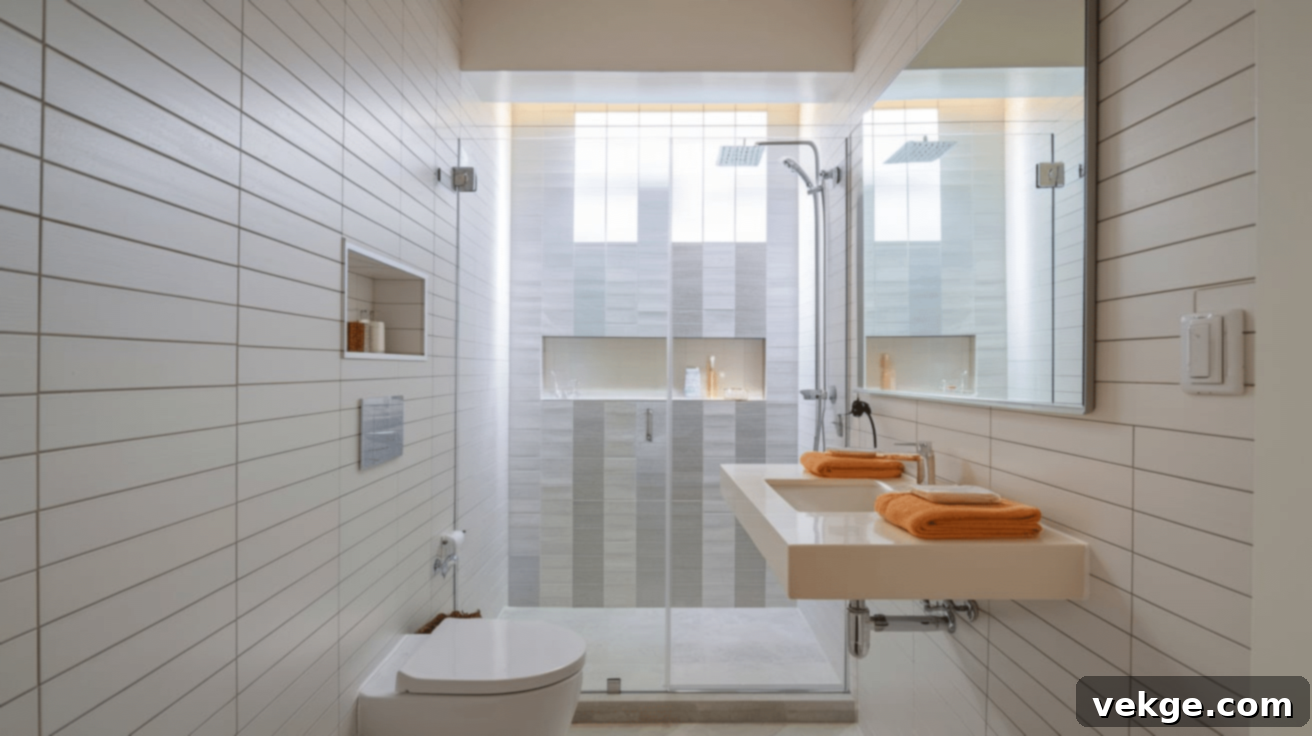
Light colors are a designer’s secret weapon for making any room feel significantly bigger and brighter. Soft, reflective shades like brilliant white, calming beige, or sophisticated light gray maximize natural and artificial light, creating an open, airy, and expansive atmosphere. While you can introduce subtle pops of color through accessories like towels or a stylish mirror frame, maintaining a light primary color palette will prevent the space from feeling cramped or enclosed, enhancing the illusion of space. For a touch of contrast without overpowering the room, consider darker floor tiles or a single accent wall, ensuring the overall effect remains bright and inviting.
2. Go for Large Tiles

Opting for large format tiles is a clever visual trick that drastically reduces the number of grout lines, creating a more seamless and expansive look in a small wet room. Fewer grout lines not only contribute to a cleaner, more spacious aesthetic but also significantly cut down on cleaning time, as there are fewer areas for dirt and grime to accumulate. When selecting tiles, you can choose between glossy finishes for added light reflection or matte options for a more understated elegance, but always ensure floor tiles have a slip-resistant finish for safety. For ultimate visual continuity, consider matching the floor and wall tiles to blur the boundaries of the room, making it appear much larger than its actual dimensions.
3. Install a Frameless Glass Shower Screen
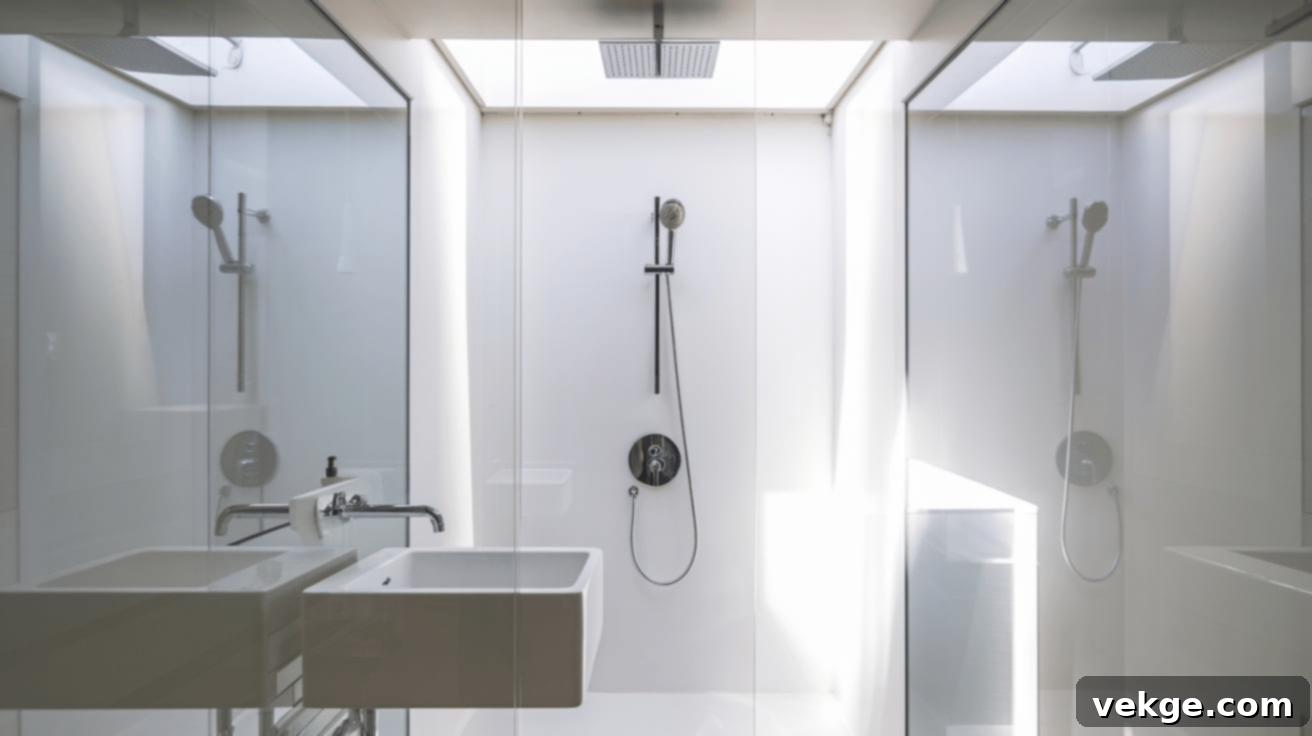
A clear, frameless glass shower screen is an essential element in a small wet room, serving to subtly delineate the shower area without visually closing off the space. Unlike bulky shower curtains or traditional framed enclosures, a frameless screen maintains the sleek, open aesthetic of the wet room while effectively preventing water from splashing into the dryer zones. Its transparency allows maximum light penetration, which is particularly beneficial in compact bathrooms with limited natural light. For those desiring a greater degree of privacy without sacrificing light, frosted or subtly textured glass panels offer an excellent alternative to clear glass.
4. Use Wall-Mounted Sinks and Toilets
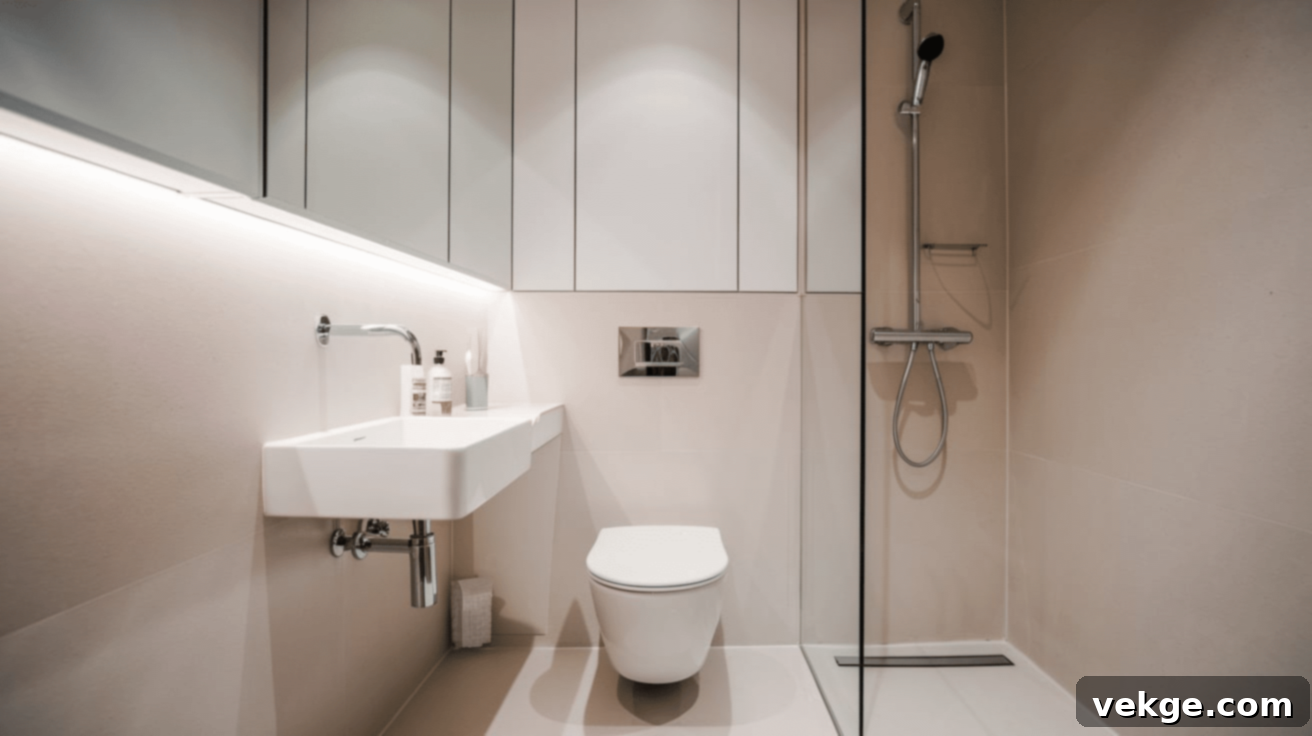
Wall-mounted fixtures, such as sinks and toilets, are design heroes in small wet rooms. By elevating off the floor, they create an illusion of increased floor space, making the room feel larger and more open. This design also significantly simplifies cleaning, as there are no pedestals or bases to clean around. With plumbing discreetly hidden within the wall, the look is incredibly clean, modern, and uncluttered, enhancing the feeling of spaciousness and ease of movement. For practical storage, opt for a wall-mounted sink with integrated shelving or a hidden cabinet. A floating toilet, similarly, makes floor mopping effortless and contributes to an overall tidy aesthetic.
5. Add a Built-In Shower Niche
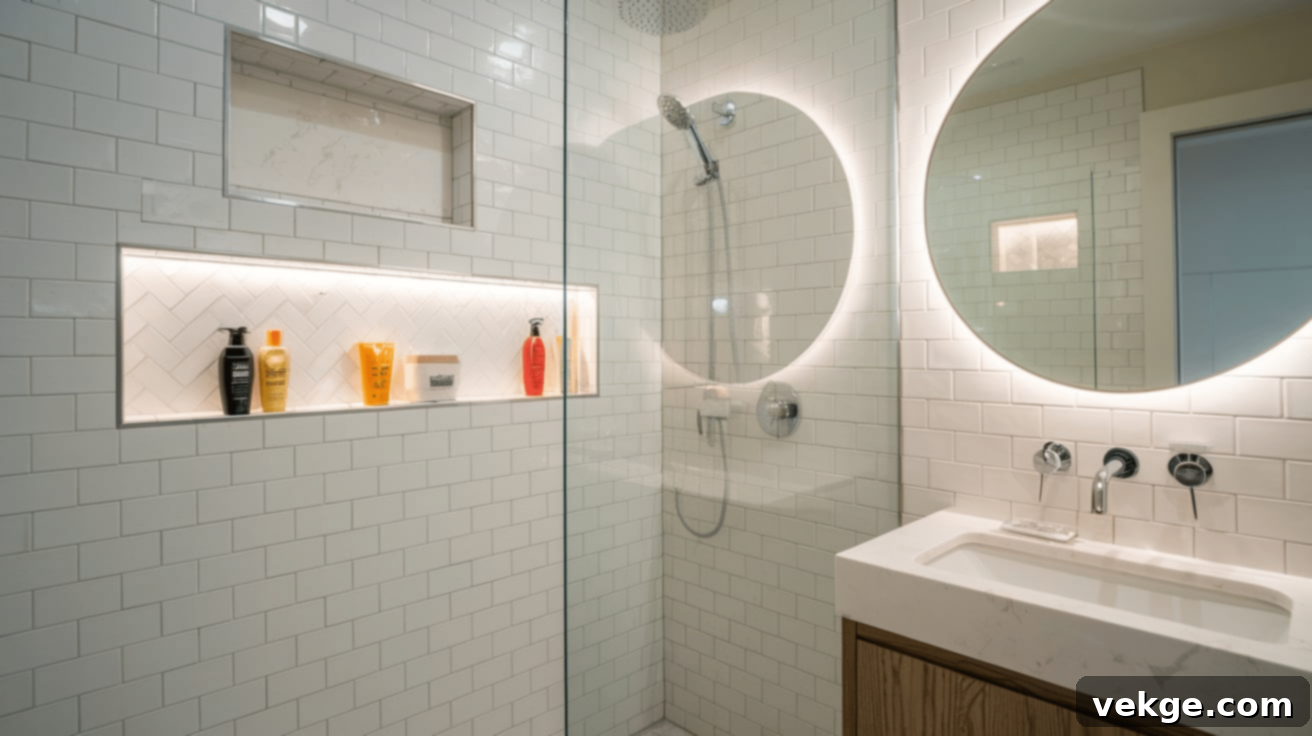
A built-in or recessed shower niche is an incredibly smart and space-saving storage solution for your wet room. Seamlessly integrated into the wall, it provides a perfect, clutter-free spot for storing shampoo, soap, conditioners, and other shower essentials without protruding into the shower area. This design keeps the wet room looking tidy and organized, eliminating the need for awkward shower caddies or bottles cluttering the floor or ledges. For a truly cohesive and high-end look, choose a tile finish for the niche that either perfectly matches or subtly complements the rest of the bathroom, ensuring it blends seamlessly into the overall design.
6. Use a Linear Drain
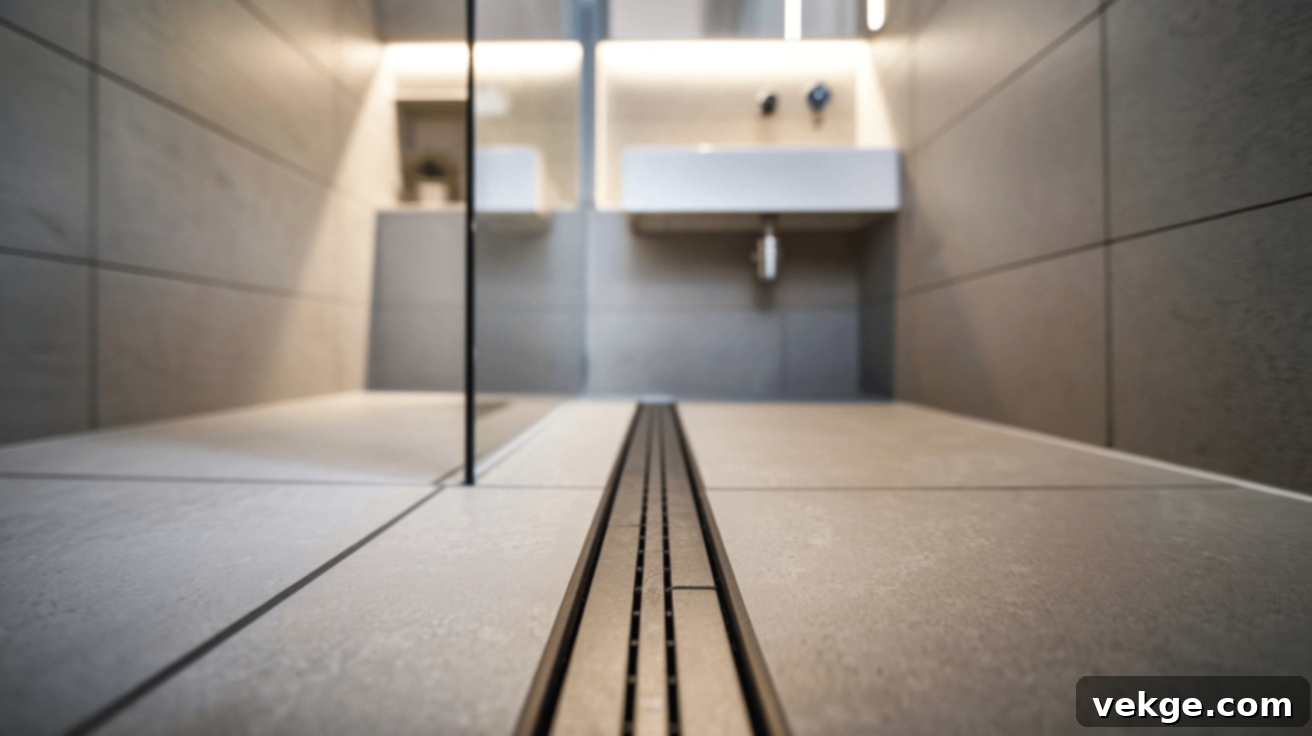
A linear drain, characterized by its long, slim profile, is a modern and highly efficient choice for any wet room, particularly in smaller spaces where aesthetics and functionality are paramount. Positioned typically at one end of the shower area, it efficiently collects and channels water away, working in harmony with a precisely sloped floor. Unlike traditional round drains, a linear drain offers a sleek, minimalist appearance that blends discreetly into the floor design, enhancing the contemporary feel of the room. Its design also reduces the potential for water pooling in various areas, ensuring superior drainage efficiency and maintaining the pristine condition of your wet room floor.
7. Add Underfloor Heating
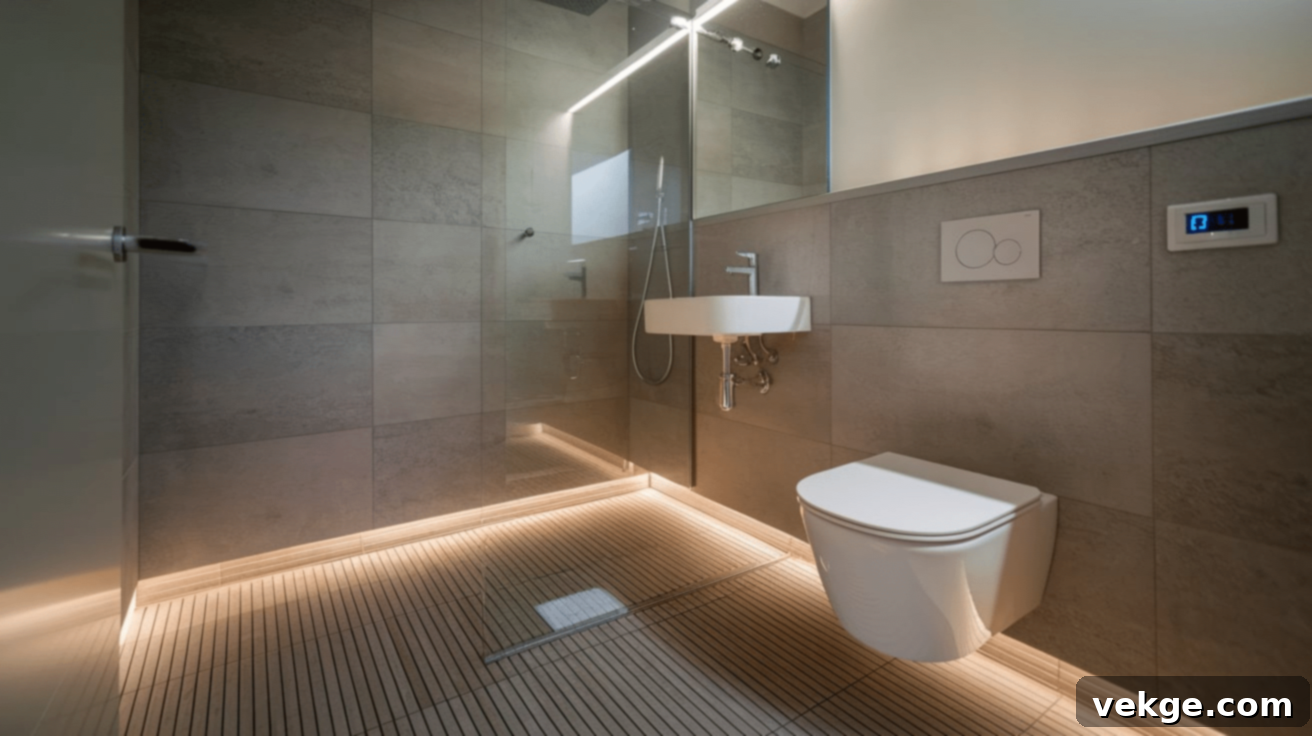
Wet rooms, by their open nature, can sometimes feel cooler than traditional bathrooms. Installing underfloor heating is an excellent way to introduce luxurious warmth and comfort, transforming the space into a cozy retreat. Beyond comfort, it plays a practical role by helping the floor dry significantly faster after use, which in turn reduces the risk of slips and inhibits mold or mildew growth. Unlike bulky radiators that consume valuable wall space, underfloor heating is entirely hidden beneath the tiles, contributing to an uncluttered, minimalist aesthetic. It’s an energy-efficient option that provides consistent, even heat distribution throughout the entire wet room, enhancing the overall user experience.
8. Choose Waterproof Wall Panels
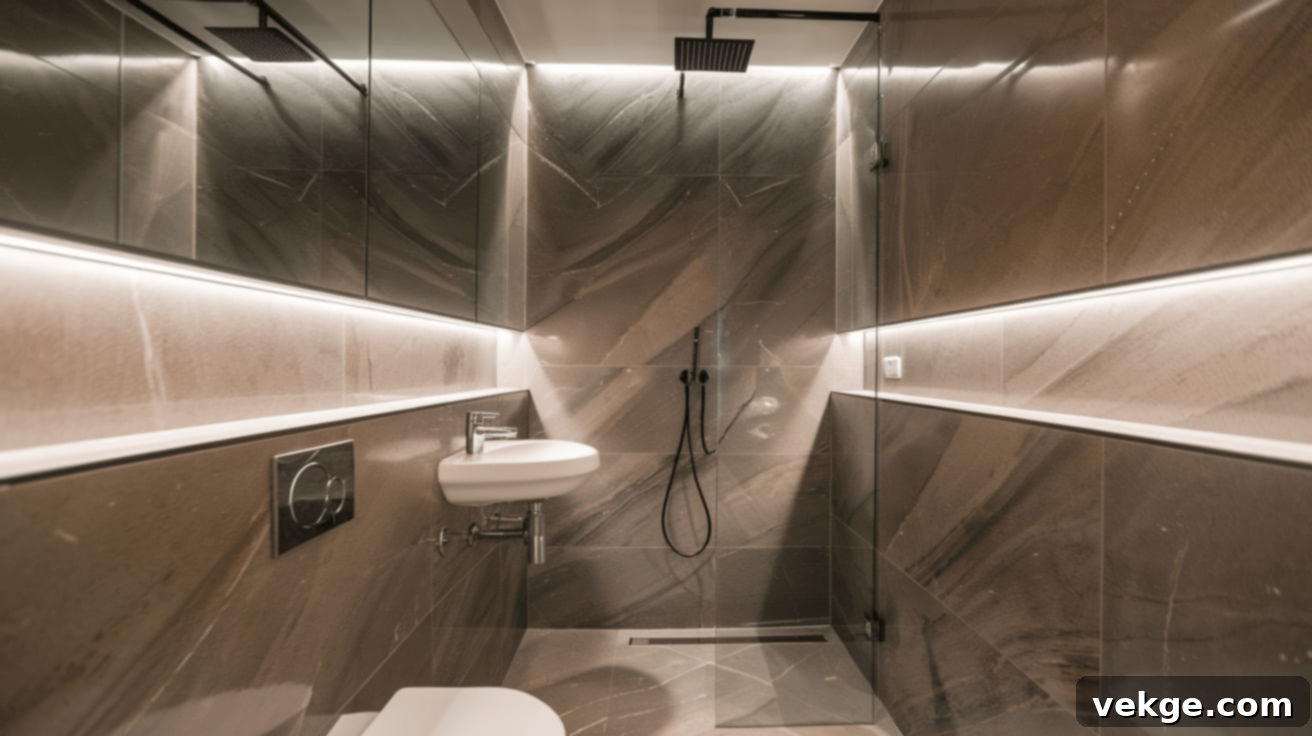
For a sleek, contemporary, and often more cost-effective alternative to traditional tiling, consider using waterproof wall panels. These panels come in an extensive range of colors, textures, and finishes, allowing for easy customization to match any design aesthetic, from minimalist to luxurious. A significant advantage is the absence of grout lines, which not only provides a seamless visual appeal but also makes them incredibly easy to clean and far less susceptible to mold and mildew buildup over time compared to tile grout. If you’re aiming for a high-end look without the expense of natural stone, panels with stone or marble effects offer a stunningly realistic and practical solution.
9. Install a Floating Vanity

A floating vanity is a stellar choice for a small wet room, effectively providing essential storage without encroaching on the precious floor space. Mounted directly to the wall, it keeps the floor clear underneath, enhancing the perception of openness and making the room feel considerably larger. To maximize utility, select a vanity with integrated drawers or shelves for discreet storage of toiletries and essentials. When installing, consider placing it at a comfortable height that ensures easy access while maintaining its sleek design. Choosing a light-colored or mirrored finish for the vanity can further aid in reflecting light, contributing to a brighter and more expansive atmosphere in your compact wet room.
10. Use Mirrors to Reflect Light
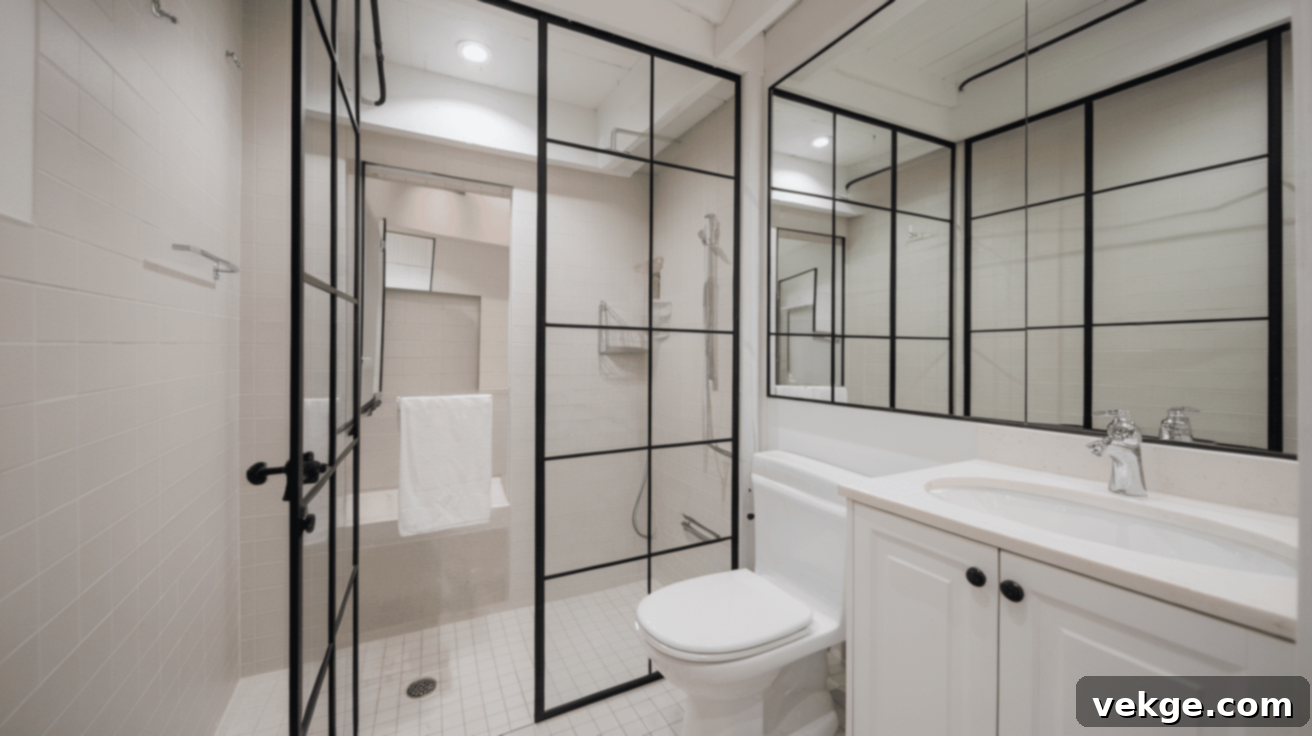
Strategic placement of mirrors is a time-honored design trick that can magically make a small wet room appear twice its actual size. A large mirror positioned above the sink is a classic and effective choice. Alternatively, mirrored cabinet doors can offer both reflective surface area and discreet storage. For an added touch of sophistication and ambient illumination, consider a backlit mirror that provides soft, diffused lighting without taking up any extra space. In particularly narrow bathrooms, a mirror placed on a side wall can create a powerful illusion of depth. Always position mirrors opposite a window or other light source to maximize their light-reflecting and space-enhancing benefits.
11. Opt for a Ceiling-Mounted Showerhead
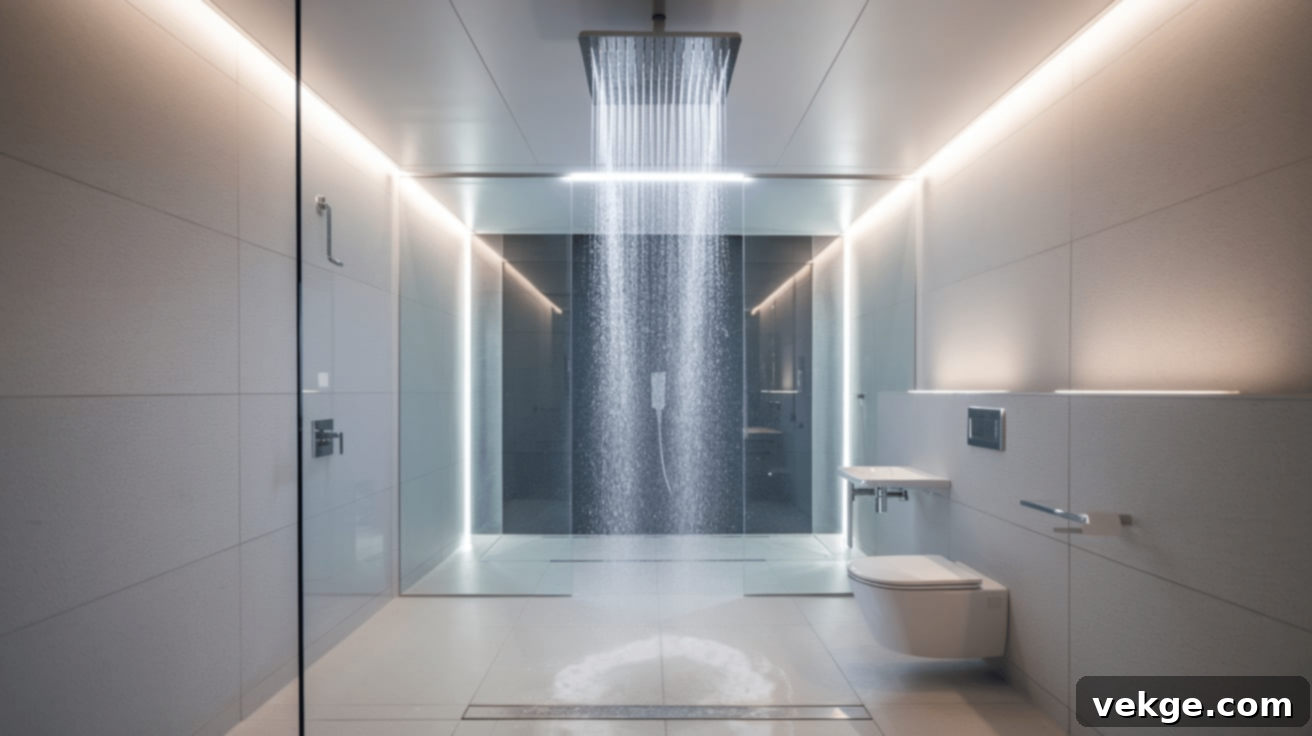
A ceiling-mounted rain showerhead is a superb choice for a small wet room, offering both space-saving benefits and a touch of luxurious elegance. This type of showerhead eliminates visible pipework and provides a wide, even distribution of water, minimizing splashes outside the designated shower zone. Its sleek, minimalist design contributes to an uncluttered aesthetic and works exceptionally well in compact spaces, enhancing the spa-like feel. If a ceiling mount isn’t feasible due to ceiling height restrictions, a slim, wall-mounted showerhead with adjustable height options can offer a similar aesthetic and practical advantage, keeping the space open and functional.
12. Add Smart Storage Solutions
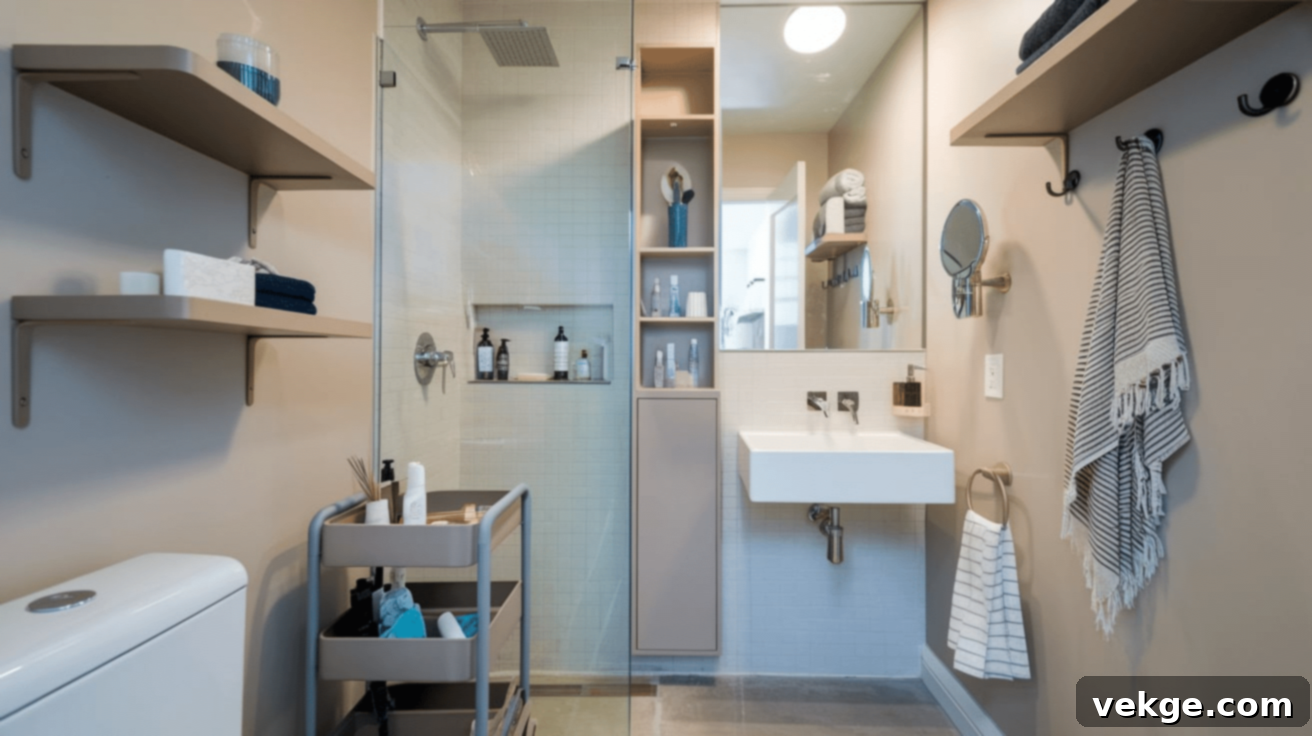
In a small wet room, intelligent storage is paramount to maintain order and prevent clutter. Embrace vertical storage solutions such as elegant floating shelves or tall, slender cabinets that draw the eye upward and utilize wall space efficiently. Wall-mounted hooks are ideal for towels, while stylish hanging baskets can neatly store toiletries. Consider investing in storage baskets that can be discretely tucked away beneath a floating vanity or a slim, mobile rolling cart that offers flexibility and can be moved out of the way when not in use. The key is to keep essentials organized and easily accessible without overwhelming the compact space.
13. Go for a Minimalist Look
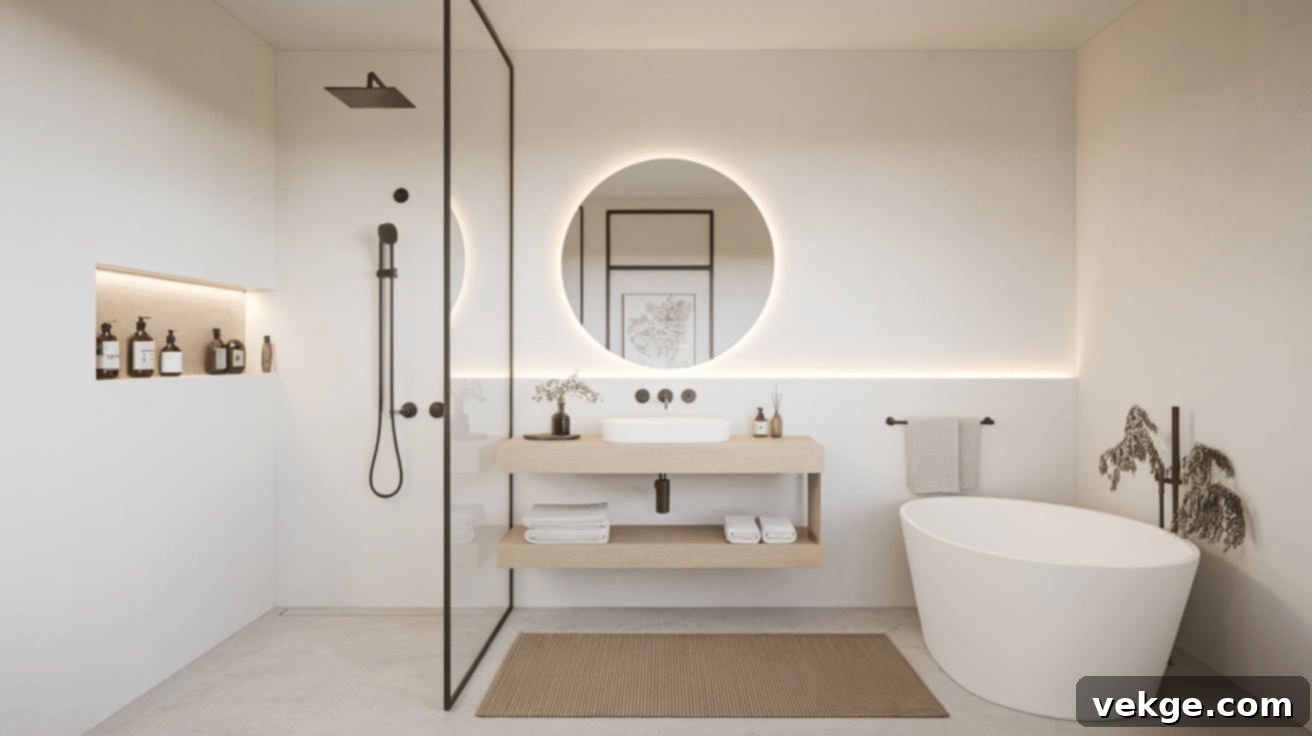
Embracing a minimalist design aesthetic is particularly effective in small wet rooms, as it naturally contributes to an uncluttered and expansive feel. Focus on clean lines, a subdued color palette, and streamlined fixtures that blend seamlessly into the environment. Resist the urge to over-decorate with numerous accessories; instead, let the inherent simplicity and functionality of the space shine. Rather than many small decorative pieces, select one or two impactful statement features, such as a subtly textured accent tile or a strikingly designed mirror, to add character without making the room feel busy or confined.
14. Use a Sliding Door
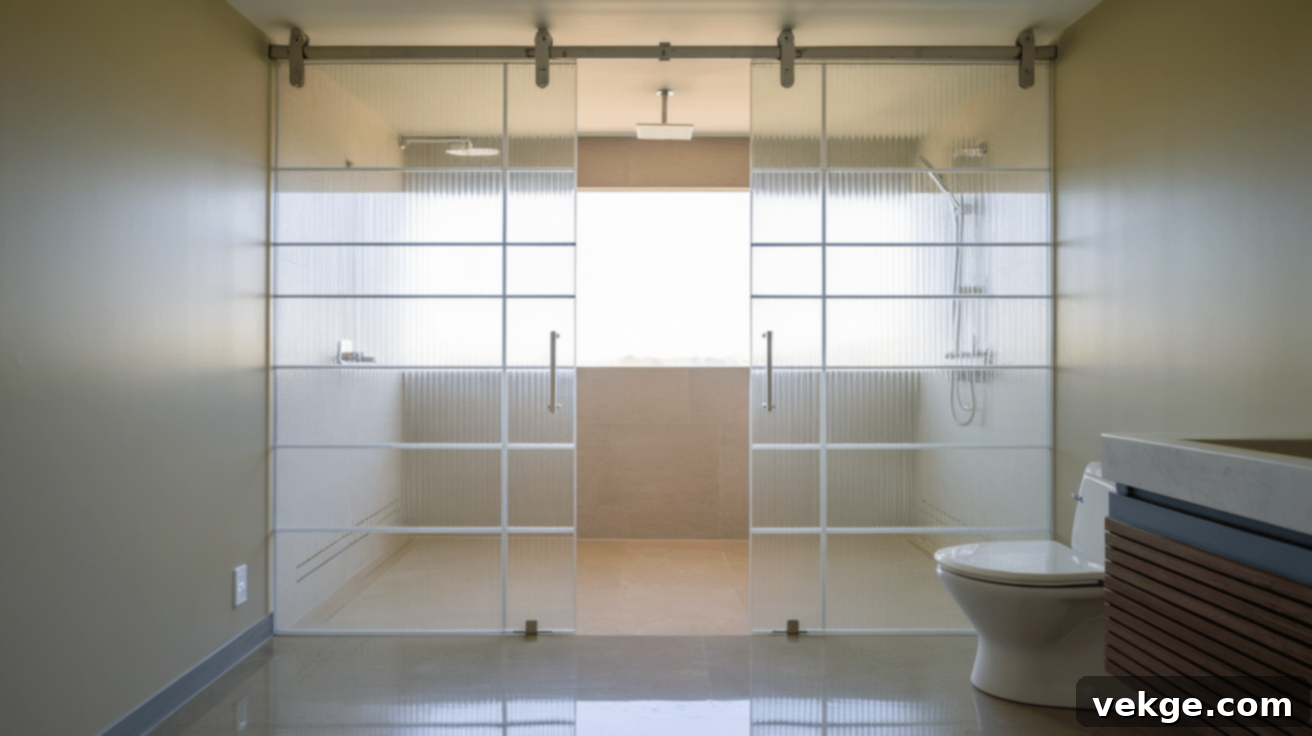
Traditional hinged doors require a significant amount of swing space, which can be a major disadvantage in a small wet room. A sliding door, on the other hand, glides smoothly along a track, either within or alongside the wall, making it an excellent space-saving alternative. This type of door ensures maximum floor space remains usable, enhancing both the accessibility and modern aesthetic of your wet room. If a full sliding pocket door installation isn’t feasible, consider a sleek barn-style sliding door or even a bi-fold door that folds neatly against the wall when opened, both offering space-efficient entryways.
15. Install LED Strip Lighting
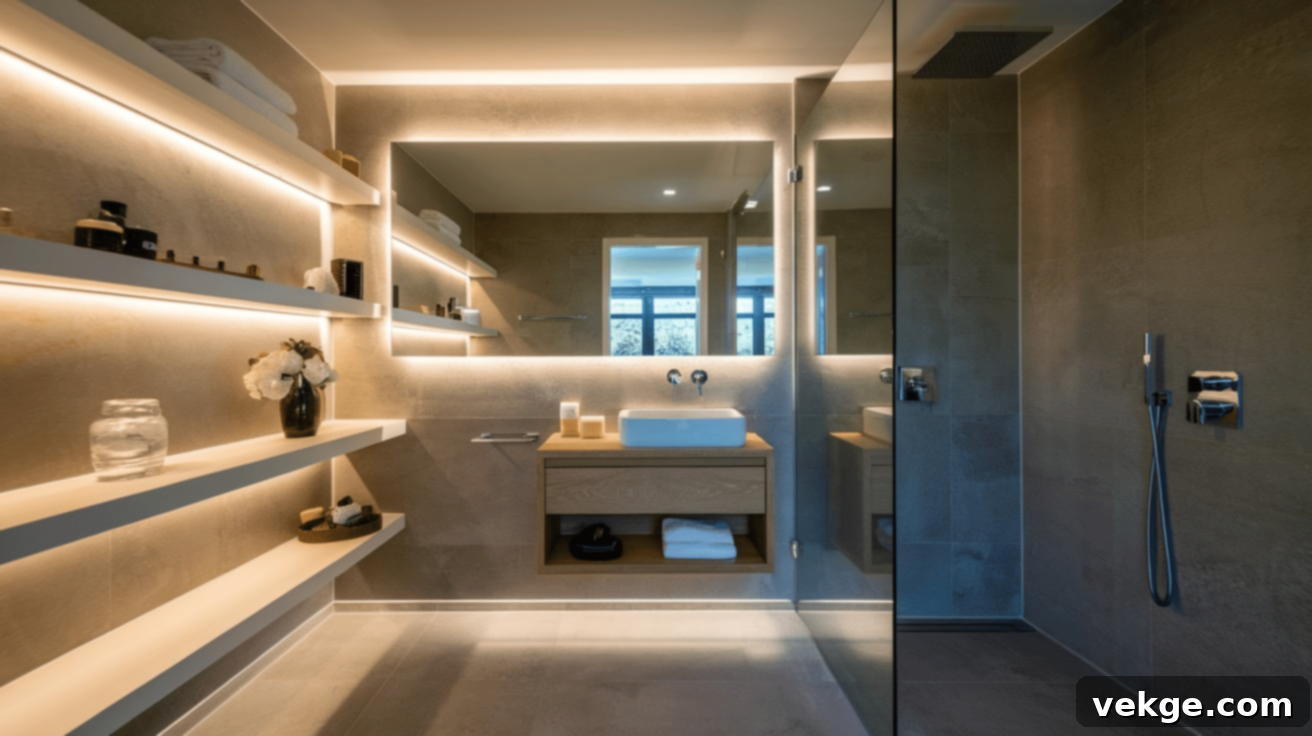
LED strip lighting is a versatile and stylish addition to any small wet room, capable of transforming its ambiance and enhancing its modern appeal. Discreetly installed under floating shelves, behind mirrors, or along the floor perimeter, these lights cast a soft, inviting glow that makes the space feel more contemporary and expansive. Beyond their aesthetic contribution, LED strips can create a relaxing, spa-like atmosphere, perfect for unwinding. Warm-toned LEDs can imbue the room with a cozy, welcoming feel, while cool-toned LEDs will emphasize a crisp, clean, and ultra-modern look, allowing you to tailor the mood of your wet room.
16. Keep Flooring Consistent

Maintaining a consistent flooring material throughout the entire wet room is a powerful design strategy for creating a seamless and visually expansive effect. By eliminating breaks or changes in flooring, the eye is allowed to travel uninterrupted across the space, making the room feel significantly larger and more cohesive. For safety, it is imperative to choose non-slip tiles or flooring materials that provide excellent grip, especially in a perpetually wet environment. Matte-finish tiles are often a good choice, as they offer superior traction and also reduce reflections that can sometimes make a small, shiny space feel busier or more confined.
17. Add a Small Bench or Seat
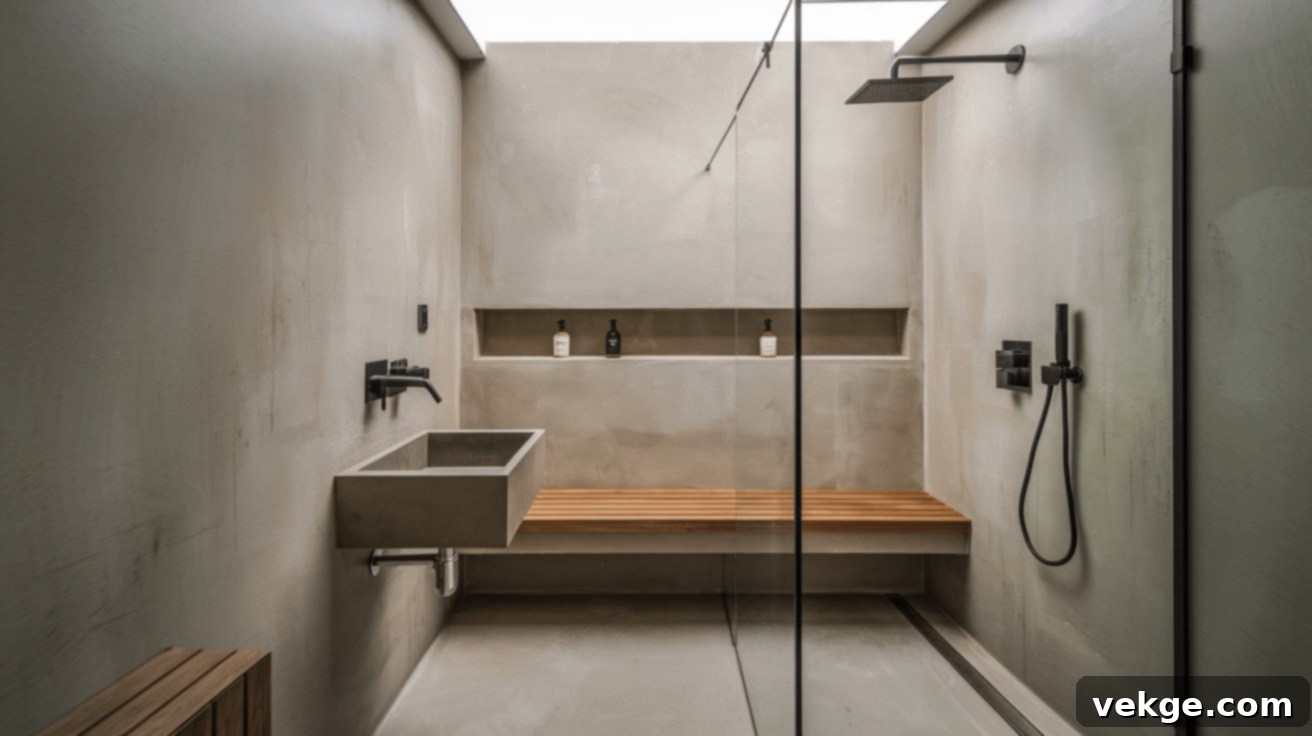
Incorporating a small bench or seat, whether built-in or a stylish foldable option, adds a layer of comfort, convenience, and functionality to your wet room. This feature is particularly beneficial for individuals with mobility challenges, providing a safe and stable spot to sit while showering. Beyond accessibility, a shower seat offers a handy surface to place toiletries, shaving tools, or simply to relax. To ensure visual harmony, choose a material that either perfectly matches or beautifully complements the existing flooring or wall tiles. Always opt for a water-resistant finish to protect against moisture damage and ensure its long-term durability in the wet environment.
18. Use Frosted Glass for Privacy
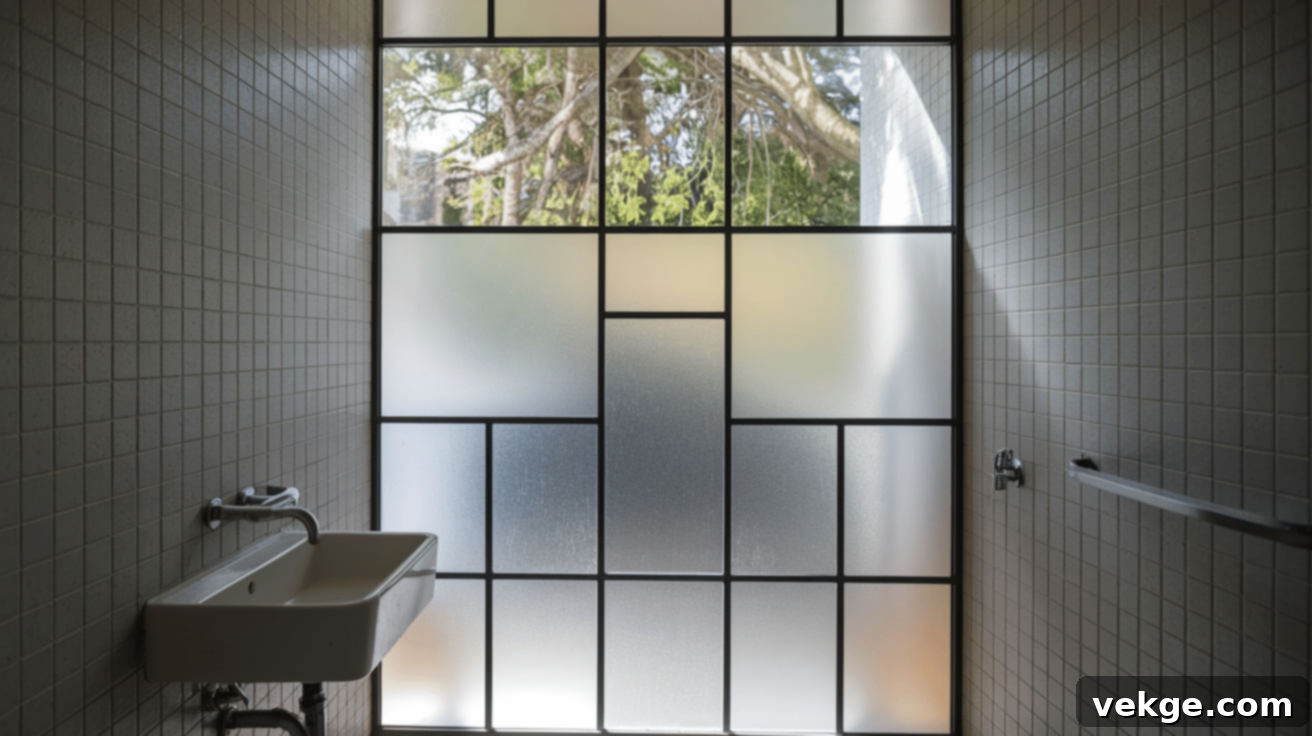
If your wet room includes a window, frosted or textured glass is an excellent choice. It allows ample natural light to flood the space, preserving the bright and airy feel, while simultaneously providing essential privacy without the need for curtains or blinds that can become damp. Similarly, if you desire a greater degree of separation between the shower area and the rest of the wet room, a frosted glass partition offers a sophisticated and practical alternative to clear glass screens. For an extra layer of privacy, consider the overall layout and, if possible, position the main shower zone further away from the entrance.
19. Hang a Heated Towel Rail
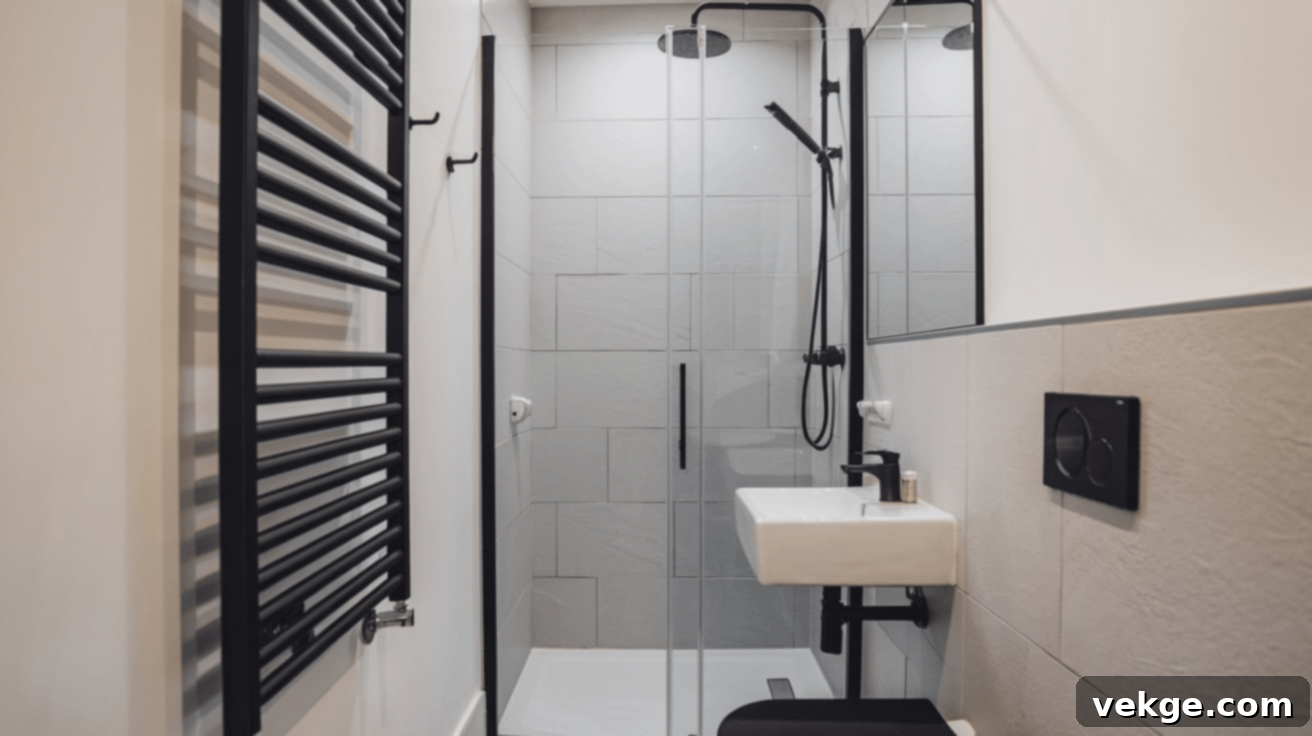
A heated towel rail is a multi-functional addition to any wet room, offering practical benefits and a touch of luxury. It ensures your towels are always warm, dry, and ready for use, significantly reducing dampness and humidity within the bathroom environment. Furthermore, a heated towel rail doubles as a supplementary heating source for the space, contributing to a cozier and more comfortable atmosphere. Opt for a sleek, wall-mounted design to save valuable floor space while keeping towels conveniently within reach. When selecting, consider an energy-efficient model to keep running costs low, all while adding a stylish and sophisticated element to your bathroom design.
20. Choose a Simple and Functional Faucet
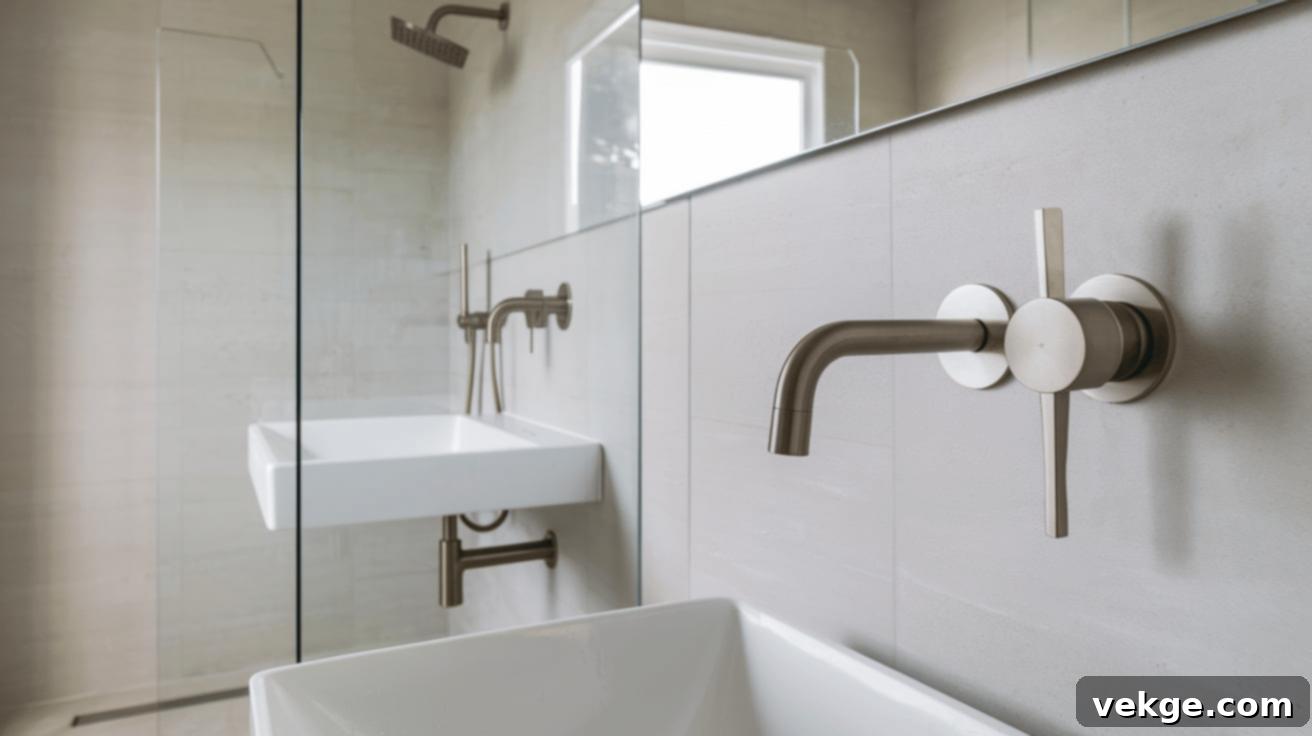
In a small wet room, every fixture contributes to the overall aesthetic and functionality. Selecting a simple, sleek, and highly functional faucet is crucial. A wall-mounted faucet is an excellent choice as it frees up valuable counter space around the sink, contributing to a tidy and uncluttered look. A single-handle design is particularly user-friendly, allowing for easy and precise control over both water temperature and flow without introducing visual clutter. To minimize unsightly water spots and fingerprints, consider a modern brushed metal finish, which not only looks elegant but also simplifies daily maintenance, keeping your wet room perpetually pristine.
Budget-Friendly and Maintenance Tips for a Small Wet Room
Creating a stylish and highly functional wet room doesn’t necessarily require an exorbitant budget, nor does its maintenance have to be a constant chore. With a few smart choices and consistent habits, you can achieve a beautiful wet room that remains pristine without breaking the bank. Here are some simple yet effective ways to save money during installation and streamline your maintenance routine.
Budget-Friendly Tips
1. Choose Affordable Tiles: While exotic tiles can be tempting, large-format ceramic or porcelain tiles offer an excellent, budget-friendly alternative. They are durable, water-resistant, and their larger size helps make the space visually expansive by reducing grout lines. Fewer grout lines also translate to less grout to clean and maintain over time, offering long-term savings in effort and potentially upkeep costs.
2. Use Waterproof Wall Panels: Instead of investing in expensive, custom tile installations, consider high-quality waterproof wall panels. These panels are often more cost-effective, significantly easier and quicker to install (potentially saving on labor costs), and their grout-free surface makes them exceptionally easy to clean and maintain. They come in a variety of styles, including realistic stone or marble effects.
3. Opt for a Simple Drain: While linear drains offer a sleek look, a basic, centrally located square or round drain can be equally effective and significantly less expensive. The key is to ensure the floor is properly sloped towards it, guiding all water efficiently to prevent pooling. Functionality should always take precedence, and a simpler drain can perform just as well.
4. Go for a DIY-Friendly Shower Kit: For those comfortable with DIY projects, pre-made wet room shower kits provide all the necessary components for effective waterproofing and drainage. These kits are generally more affordable than bespoke installations and can save you a substantial amount on professional labor, making a wet room more accessible for budget-conscious homeowners.
5. Buy Second-Hand Fixtures: Don’t overlook the potential savings in second-hand or ex-display fixtures. Online marketplaces, architectural salvage yards, and discount bathroom stores are excellent places to find gently used sinks, toilets, and vanities that are still in superb condition. You can often discover high-quality, stylish pieces at a fraction of their original retail price, adding character on a budget.
Maintenance Tips
1. Squeegee the Floor and Walls Daily: One of the simplest yet most effective maintenance habits is to squeegee down the shower walls and floor immediately after each use. This quick action removes excess water, preventing unsightly water spots, limescale buildup, and significantly reducing the conditions favorable for mold and mildew growth, keeping your wet room looking pristine.
2. Keep Grout Clean: If your wet room features tiled surfaces, consistent grout maintenance is crucial. A weekly scrub with a simple paste of baking soda and water can work wonders in preventing stains and the dreaded black mildew that often forms in damp grout lines. For stubborn areas, a dedicated grout cleaner or a bleach solution (used sparingly) can be applied.
3. Install Proper Ventilation: A high-quality extractor fan is indispensable for a wet room. Ensure it’s correctly sized for your bathroom’s volume and always leave it running for at least 10-15 minutes after showering. This effectively removes moisture-laden air, preventing condensation buildup on surfaces, keeping the room fresh, and inhibiting mold growth.
4. Use Anti-Mold Sealant: As a preventive measure, periodically inspect and reapply an anti-mold sealant to grout lines and around the base of fixtures (like the toilet or sink). This creates an impenetrable barrier against water penetration, actively preventing leaks and significantly reducing the likelihood of mold and mildew taking hold in vulnerable areas.
5. Choose Easy-to-Clean Fixtures: When selecting fixtures, prioritize designs that simplify cleaning. Wall-mounted sinks and toilets are prime examples, as they leave the floor clear, making mopping effortless and preventing dust and grime from accumulating around bases. Similarly, smooth, non-porous surfaces for vanities and shower panels are easier to wipe clean.
Conclusion
A small wet room offers an exceptional solution for modern living, proving that limited space doesn’t mean sacrificing style or functionality. By embracing clever design choices, you can transform even the most compact bathroom into an open, elegant, and highly efficient sanctuary. Simple yet impactful tricks such as utilizing light colors, opting for large format tiles, and integrating wall-mounted fixtures can dramatically enhance the perception of space and improve the overall flow.
Furthermore, smart planning, from meticulous waterproofing and efficient drainage to thoughtful ventilation, ensures your wet room is not only beautiful but also durable and safe. For those mindful of expenses, there are numerous budget-friendly options, including choosing affordable tiles, waterproof wall panels, or even sourcing second-hand fixtures, allowing you to create your dream wet room without financial strain. Whether you’re undertaking a complete remodel or simply seeking innovative ideas to refresh your current bathroom, the insights provided in this guide will empower you to design a wet room that perfectly suits your space, lifestyle, and budget. Small wet rooms are truly efficient, offering a sleek, modern aesthetic coupled with superior accessibility and ease of maintenance, ultimately making your bathroom a better place to be.
Frequently Asked Questions
Do wet rooms cause water damage?
Not if they are properly designed and installed with meticulous waterproofing. A professionally constructed wet room requires a completely sealed floor, walls, and a well-positioned, effective drainage system to prevent any leaks or moisture penetration. Employing a certified professional or using a high-quality, comprehensive DIY waterproofing kit is crucial to ensure long-term protection against water damage and maintain the integrity of your home’s structure.
What kind of flooring is best for a wet room?
For a wet room, the best flooring options are those that are both completely waterproof and slip-resistant. Popular and highly effective choices include non-slip porcelain or ceramic tiles, waterproof vinyl (especially luxury vinyl tiles or planks), and sealed concrete. Large-format tiles are particularly advantageous as they minimize grout lines, which not only makes cleaning easier but also contributes to a more expansive and seamless visual aesthetic in a small space.
How much does it cost to build a small wet room?
The cost of building a small wet room can vary significantly based on location, materials chosen, and labor rates. However, a basic wet room conversion can typically range from $3,000 to $8,000. Opting for budget-friendly materials like economical tiles or waterproof wall panels, alongside utilizing DIY-friendly kits for waterproofing, can certainly help in lowering the overall expenditure, making the project more attainable.
Can I turn my existing bathroom into a wet room?
Yes, in most cases, an existing bathroom can be successfully converted into a wet room. This transformation typically involves a few key modifications: ensuring comprehensive waterproofing of the entire space, adjusting the floor to create the necessary slope for drainage, and potentially upgrading the flooring to a suitable waterproof and non-slip material. Consulting with a professional bathroom designer or builder is recommended to assess the feasibility and plan the conversion effectively.
Is a wet room worth it?
Absolutely, a wet room is generally considered a worthwhile investment, especially if you prioritize a modern, space-saving, and easy-to-clean bathroom. The benefits include enhanced accessibility, a luxurious spa-like aesthetic, and the potential to increase your home’s value. The key to its worth lies in proper design and installation; when executed correctly, a wet room offers unparalleled functionality and style, making it a highly desirable addition to any home.
